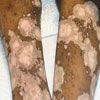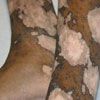- Clinical Technology
- Adult Immunization
- Hepatology
- Pediatric Immunization
- Screening
- Psychiatry
- Allergy
- Women's Health
- Cardiology
- Pediatrics
- Dermatology
- Endocrinology
- Pain Management
- Gastroenterology
- Infectious Disease
- Obesity Medicine
- Rheumatology
- Nephrology
- Neurology
- Pulmonology
What Caused These Dyspigmented Lesions in an HIV-Infected Man?
A 38-year-old African American man with HIV infection presents with numerous dyspigmented macules and patches on the extremities, abdomen, and chest; the lesions are smooth, nontender, and minimally pruritic.

Figure 1

Figure 2
A 38-year-old African American man with HIV infection presents with numerous dyspigmented macules and patches on the extremities, abdomen, and chest; the lesions are smooth, nontender, and minimally pruritic. He has been noncompliant with antiretroviral therapy since his diagnosis 3 years earlier.
During the first 3 to 4 months after the HIV infection was diagnosed, the skin of the patient's extremities and trunk became intensely pruritic. Initially, he noticed no rash or lesions, then pea-sized nodules appeared in the areas of chronic scratching. Application of corticosteroid cream provided little relief. Further itching and scratching of the nodules led to the pigmentation changes shown here.
Which of the conditions in the differential is the likely diagnosis?A. Vitiligo
B. Scabies
C. Bullous pemphigoid
D. Prurigo nodularis
E. Kaposi sarcoma
(Answer on next page.)

Figure 1

Figure 2
Prurigo nodularis is characterized by numerous nodules and papules that develop after a period of intense itching and scratching. The 0.5- to 2-cm, dome-shaped, scaly lesions are often found on the arms, legs, and anterior chest; the face, palms, soles, and hard-to-reach areas--such as the back--are spared. Postinflammatory changes with dyspigmentation (as seen in this patient), scarring, and erythematous areas frequently develop in affected persons.1,2
Although the exact cause of prurigo nodularis is unknown, the condition often occurs in immunocompromised patients, such as those with underlying disorders (eg, HIV infection with a CD4 count of less than 50/µL, chronic renal failure, hepatic dysfunction, and iron deficiency). It is also more common in patients with darker skin and in those who have increased emotional stress.1,3,4
The Table lists conditions in the differential diagnosis of dyspigmented macules and patches in patients with HIV infection.5,6 Diagnosis of prurigo nodularis is primarily based on the history and clinical presentation. An underlying malignancy and hepatic or renal dysfunction can be ruled out with laboratory studies, such as a complete blood cell count and metabolic panel; the results of these studies were negative in this patient.
A biopsy specimen from the nodules reveals marked hyperkeratosis and acanthosis of the epidermis. Nerve fiber hyperplasia and patchy inflammation are also found.5,7
Treatment of prurigo nodularis is challenging; it includes a combination of counseling, antipruritic and antianxiety agents, topical and intralesional corticosteroid injections, cryotherapy, and phototherapy.8 Immunomodulators, such as thalidomide, have been tried.8 Patient education about the importance of terminating the itch-scratch cycle is essential.
References:
REFERENCES:1. Han A, Koo JYM. Psychocutaneous diseases. In: Bolognia JL, Jorizzo JL,Rapini RP, et al, eds. Dermatology. New York: Mosby; 2003:116-117.
2. Soter NA. Nummular eczema and lichen simplex chronicus/prurigo nodularis.In: Freedberg IM, Eisen AZ, Wolff K, et al, eds. Fitzpatrick’s Dermatologyin General Medicine. 6th ed. New York: McGraw-Hill; 2003:1196-1197.
3. Maurer TA. Dermatologic manifestations in HIV infection. Top HIV Med.2005;13:149-154.
4. Hyde JN, Montgomery FH. A Practical Treatise on Diseases of the Skin forthe Use of Students and Practitioners. Philadelphia: Lea Brothers; 1909:174-175.
5. Penneys NS. Skin Manifestations of AIDS. Philadelphia: JB Lippincott Co;1990:95-108, 143-147.
6. Mathieu ME, Wilson BB. Scabies. In: Mandell GL, Bennett JE, Dolin R, eds.Principles and Practice of Infectious Diseases. 4th ed. Philadelphia: ChurchillLivingstone; 2000:2974-2976.
7. Habif TP. Clinical Dermatology: A Color Guide to Diagnosis and Therapy. 4thed. Philadelphia: Mosby; 2000:68.
8. Maurer T, Poncelet A, Berger T. Thalidomide treatment for prurigo nodularisin human immunodeficiency virus-infected subjects: efficacy and risk of neuropathy.Arch Dermatol. 2004;140:845-849.
